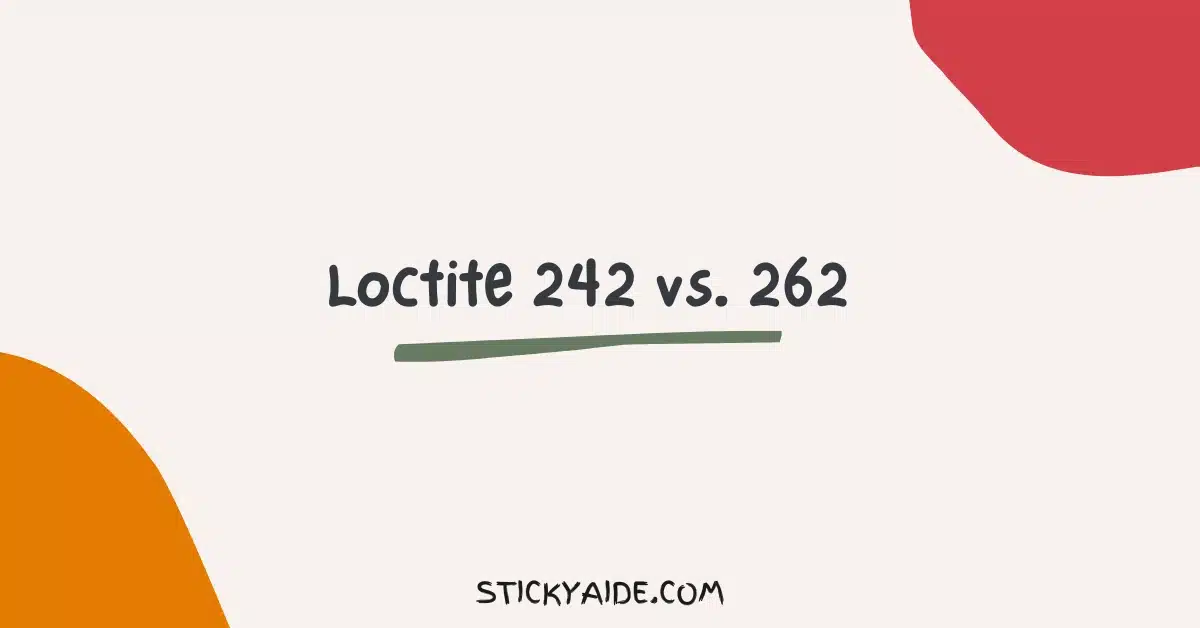Loctite threadlockers are one of the most popular options for threadlockers and are widely used for various components and machinery. Loctite differentiates between the intended purposes and strength of the threadlocker by offering them in multiple colors.
Loctite 242 and 262 come in Blue and Red, respectively, and even though they are both threadlockers to prevent loosening and leakage of threaded fasteners, they vary. So, in the battle between Loctite 242 vs. 262, which one should you side with and why? I’ll review the features, characteristics, and differences between Loctite 242 and 262.
Read More: Loctite 242 vs. 271
Read More: Loctite PL 8x vs. PL Max
Loctite 242 vs. 262
Overview of Loctite 242
Loctite 242 is a medium-strength threadlocker manufactured by Loctite-Henkel that comes in Blue. Loctite 242 is a Dimethacrylate-ester-based threadlocker and cures in the vacuum between confined metal spaces.
Loctite 242, being blue-colored, means you can disassemble your components using standard household tools after using the adhesive. Loctite 242 is resistant to vibration, shock, corrosion, and a few other environmental factors when wholly cured.

Loctite 242 has medium viscosity and is thixotropic, so there’s less risk of the threadlocker running after you apply it. Loctite 242 suits all metals and common substrates like steel, stainless steel, or brass.
Due to the strength and durability of the 242, you can use it for a range of applications around your house or outdoors. You can use Loctite 242 for – nuts and bolts of your engine components, transmission or suspension systems, pumps, motors, or other components.
Like other Loctite threadlockers, the 242 is resistant to contamination from common industrial oils, lubrication or cutting oils, or other contaminants.
Loctite 242 can also withstand extremely high or low temperatures and has a working temperature range between -55 to 150 °C. You can purchase Loctite 242 in a 0.5 ml tube or bottles of – 10 ml, 50 ml, 250 ml, and 1 liter.
Read More: Loctite 242 vs. 243
Read More: Loctite 262 vs. 272
Overview of Loctite 262
Loctite 262 is a heavy-strength threadlocker made by Loctite-Henkel, which comes in Red. Loctite 262, being red-colored, means it holds a permanent and robust bond between the surfaces once wholly cured.
Loctite 262 is a methacrylate-ester-based adhesive and cures anaerobically. You can use Loctite 262 for all metals and substrates like stainless steel or steel. Loctite 262 has a fast fixture time for Brass, around only 8 minutes, while fixture time for steel is 15 minutes.
A complete cure of Loctite 262 can take up to 24 hours, and once it’s fully cured, it provides a robust bond between surfaces, resistant to shock, vibration, and other environmental hazards. You can use Loctite 262 to prevent nuts and bolts from loosening in your car components like – engine components, chassis, or other critical areas.
Read More: Loctite 262 vs. 263 vs. 271

Furthermore, you can also use Loctite 262 in various household or industrial settings like for nuts and bolts of your – pumps, motors, bearings, or other industrial machinery.
Loctite 262 is also tolerant to minor contamination from common industrial oils.Like the 242, Loctite 262 also has medium viscosity and is thixotropic. So, you can easily apply the threadlocker without worrying about the migration of the adhesive.
Differences Between Loctite 242 And 262
Now let’s examine how Loctite 242 and Loctite 262 differ.
Ideal Uses
Loctite 242 is a blue-colored Loctite, meaning it is a medium-strength threadlocker for threaded fasteners that can be removed for repair or maintenance. It can also withstand vibration and shock and is safe for you to use on components with the risk of exposure to constant vibration.
Loctite 262 comes in Red and is a medium-to-high strength threadlocker from Loctite. You can use the 263 for fasteners in components you don’t plan to remove in the future.
Fixture and Cure Time
Loctite 242 and 262 have similar cure times. Once you apply the threadlocker, a complete cure takes around 24 hours. The Cure time depends on temperature, materials used, and bondline gap. You can speed up the curing process using an activator.
Loctite 242 has a fixture time of 5 min, 15 min, and 20 min for steel, brass, and stainless steel, respectively.
On the other hand, the 262 has a fast fixture time of only 8 minutes for brass and 15 for steel. The fixture time for Stainless Steel is around 3 hours.
Last Opinion
So, which one should you side with in the battle between Loctite 242 vs. 262? It depends on what components and purpose you need a threadlocker for.
If you need to disassemble your components later, go with Loctite 242. If you need a stronger bond and don’t plan to disassemble your components, go for 262.

